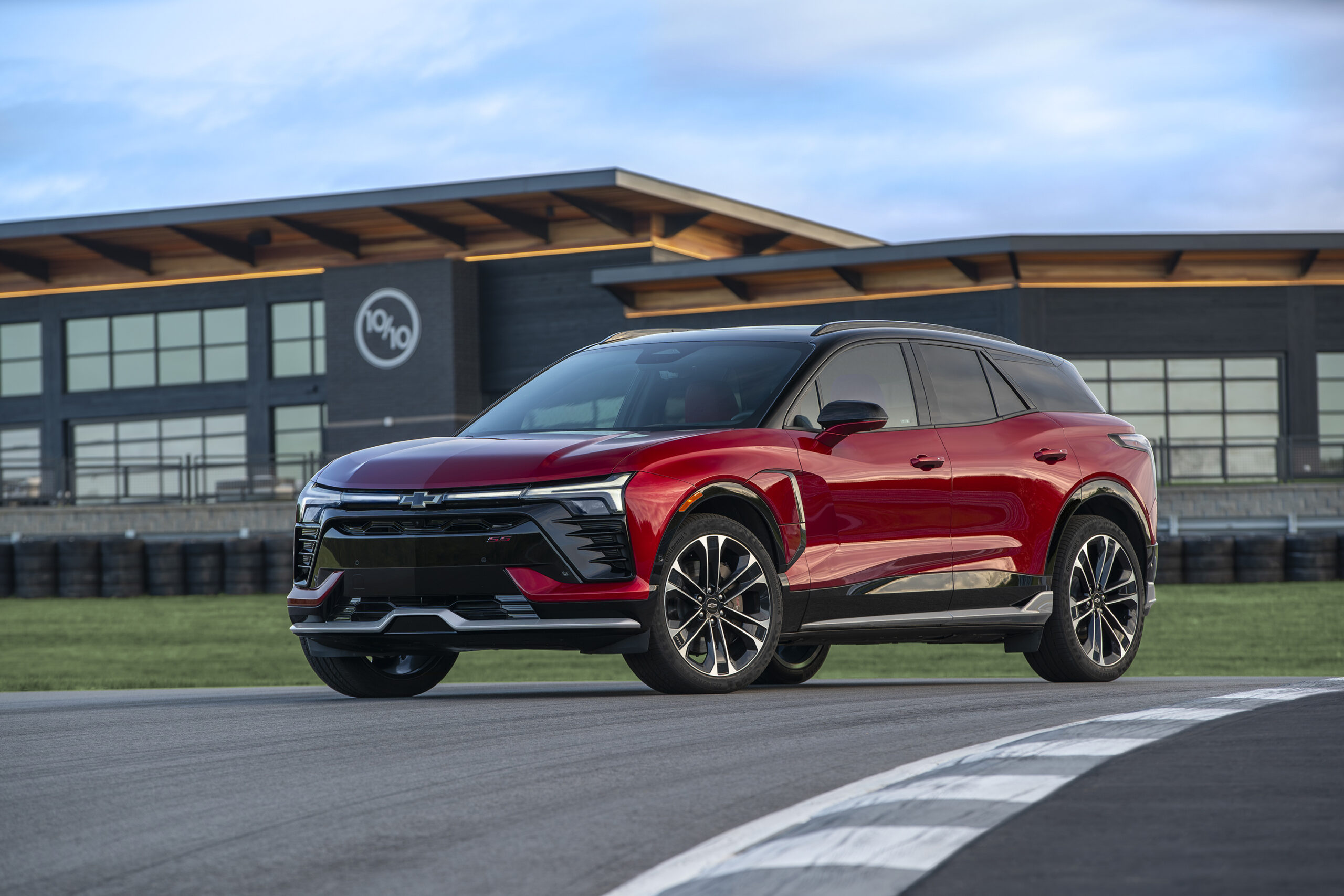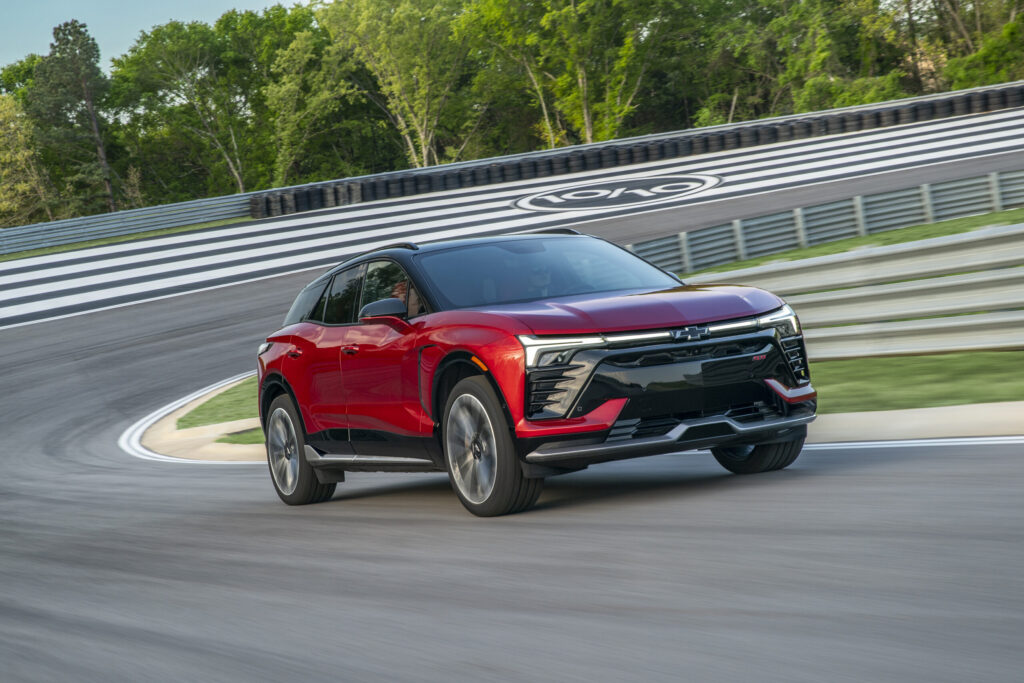Sign up for CleanTechnica’s Weekly Substack for Zach and Scott’s in-depth analyses and high level summaries, sign up for our daily newsletter, and/or follow us on Google News!

Last Updated on: 21st April 2025, 03:27 pm
Introduction

Chevrolet invited me to Charlotte to drive the new Blazer SS and tour some of their facilities in the area (they paid for my flights and hotel and food). I don’t accept invites for every car (since I just write part time), but since I was so impressed with the Equinox last year as I wrote about here and here, I decided to go. I wasn’t disappointed.
Chevrolet has long been a name synonymous with American muscle and innovation in the automotive world. With the introduction of the 2025 Blazer EV SS, it seems they’re doubling down on that reputation, but this time, with a fully electric twist. As someone who’s been tracking the evolution of electric vehicles for years — ever since gas prices started pinching my wallet back in 2010 — I was eager to see if Chevy could bring the same level of excitement and performance to the EV space that they’ve brought to their gas-powered counterparts. The Blazer EV SS isn’t just another electric SUV; it’s a statement that Chevrolet is serious about competing in the high-performance EV segment.
A year ago, I wondered if Chevy was really committed to build EVs in volume, but the last year has convinced me they have the capacity to build a lot of EVs. Of course, Trump’s tariffs or a repeal of the federal tax credit could significantly hurt demand, but I can’t fault Chevrolet for Trump’s actions. Let’s dive into what makes this vehicle stand out, and why it might just be the SUV that gets traditional automakers back in the EV game, especially as many electric car fans have soured on Tesla due to Elon’s recent political involvement. I’m not upset with Elon’s DOGE work to reduce government waste, but I can see a lot of other people (rightly or wrongly) are very upset with Elon’s actions.
Performance: A New Benchmark for Chevy

Let’s start with the numbers, because when it comes to performance, numbers tell the story. The Blazer EV SS boasts an impressive 615 horsepower and 650 lb-ft of torque, thanks to its dual-motor all-wheel-drive system (Chevrolet). This allows it to sprint from 0 to 60 mph in just 3.4 seconds (I bested that as I will explain below), making it the quickest SS model Chevy has ever produced and besting the market leader Tesla Model Y performance by a tenth of a second. For context, that’s faster than many sports cars on the market today, let alone SUVs. It’s a staggering achievement for a vehicle that also offers practicality and comfort.
But performance isn’t just about straight-line speed. The Blazer EV SS also delivers on handling and agility. With features like six available driving modes, including Sport and Snow, drivers can tailor the vehicle’s behavior to suit their needs. The Wide Open Watts (WOW) mode, exclusive to the SS trim, unlocks the full potential of the powertrain, delivering that exhilarating acceleration that EV enthusiasts crave. It’s clear that Chevy has taken notes from Tesla’s playbook, focusing on instant torque and seamless power delivery. I’ve argued before that legacy automakers need to step up their game to match Tesla’s performance edge , and it looks like Chevy is listening.
Range & Charging: Practicality Meets Performance

Despite its performance credentials, the Blazer EV SS doesn’t skimp on range. It offers an EPA-estimated 303 miles on a single charge, which is more than sufficient for most daily commutes and even longer trips, provided you plan your charging stops (GM Authority). For those who need to recharge quickly, the Blazer EV SS supports Level 2 fast charging at up to 19.2 kW, allowing for a full charge in just a few hours. Additionally, it has access to over 250,000 public chargers, including more than 20,000 Tesla Superchargers, thanks to Chevy’s partnership with Tesla. This is a game-changer for EV owners, as it provides a vast network of fast chargers that can significantly reduce range anxiety.
Another innovative feature is bidirectional charging, which allows the vehicle to act as a power source for your home or other devices. With the GM Energy PowerShift Charger and Vehicle-to-Home Enablement kit, you can use the Blazer EV SS to power your home during outages or even sell energy back to the grid, depending on your local regulations. This is especially appealing to me since I live in an area that loses power due to hurricanes every few years and this is much cheaper and better than buying a home battery. This not only adds practicality but also positions the Blazer EV SS as a forward-thinking vehicle for the future of energy. I’ve written before about this technology last year when I went to Detroit, and Chevy’s approach here is a step in the right direction.
Design & Features: Style Meets Substance

Design-wise, the Blazer EV SS cuts a striking figure. It features a bold front fascia with eye-catching headlamps and a sleek profile that hints at its performance intentions. The SS trim adds unique touches like blacked-out accents and 20-inch wheels, giving it a sporty yet sophisticated look. Inside, it’s equipped with a 10.2-inch HD color touch-screen, Google built-in for a seamless infotainment experience, and Super Cruise driver assistance, which allows for hands-free driving on compatible roads.
The interior is spacious and well-appointed, with plenty of room for passengers and cargo. The second row can accommodate three passengers comfortably, and the cargo space is generous, with 64.2 cubic feet available when the rear seats are folded down. The materials used are of high quality, and the overall fit and finish are excellent, giving it a premium feel that rivals more expensive luxury SUVs. Special editions like the Midnight Edition and Sport Edition add further customization options, allowing buyers to personalize their Blazer EV SS to their taste.
Safety: A Top Priority

Safety is a top priority for any vehicle, and the Blazer EV SS doesn’t disappoint. It comes with over 15 standard safety features, including Chevy Safety Assist, which bundles Forward Collision Alert, Automatic Emergency Braking, Front Pedestrian Braking, Lane Keep Assist, and more. These features help to prevent accidents and protect occupants, making it one of the safest vehicles in its class. Additionally, the vehicle’s robust construction and advanced driver assistance systems provide peace of mind for drivers and passengers alike. In my review of the Chevy Equinox EV, I noted how its safety features set a high standard, and the Blazer EV SS appears to follow suit.
Pricing & Value: Competitive In A Crowded Market
Pricing for the Blazer EV SS starts at $61,095, which might seem steep at first glance. However, when you consider the performance, features, and technology on offer, it’s competitively priced against other high-performance EVs. For comparison, the Tesla Model Y Performance was a great value at around $50,000 but isn’t available anymore. This new Model Y doesn’t yet offer a performance trim. The Ford Mustang Mach-E GT which we have written about here, another strong contender, starts at $59,995 but falls short in terms of size, power, and torque compared to the Blazer EV SS.
Moreover, the Blazer EV SS qualifies for a federal tax credit of up to $7,500 for eligible buyers, bringing the effective price down to around $53,595. This makes it more accessible to a wider range of consumers, especially those looking for a high-performance EV without breaking the bank. When you factor in the long-term savings on fuel and maintenance — EVs can save thousands over their lifetime, as I’ve noted in past articles like this one — the Blazer EV SS represents excellent value for money.

Market Context: Chevy’s Bold Move





In the crowded EV SUV market, the Blazer EV SS stands out for its blend of performance and practicality. Tesla’s Model Y Performance has been discontinued in the US, offering Chevy a market opportunity. On the other hand, the Ford Mustang Mach-E GT is another strong contender, but the Blazer EV SS edges it out with more room, power, and torque. Chevrolet is positioning this vehicle not just as another EV, but as a performance icon, and that’s a bold move that could pay off.
Traditional automakers like Chevy have often been criticized for being slow to embrace EVs, but the Blazer EV SS shows that they’re catching up quickly. By electrifying the SS badge, Chevy is sending a message that electric vehicles can be just as exciting and capable as their gas-powered counterparts, if not more so. It’s exciting to see the EV landscape becoming more diverse and competitive, as it ultimately benefits consumers with more choices and better technology. I’ve written before about how legacy automakers need to innovate to stay relevant (CleanTechnica Toyota article), and Chevy’s efforts here are a step in the right direction.
Potential Drawbacks
Of course, no vehicle is perfect, and the Blazer EV SS has a few areas where it might fall short. One is its range compared to some competitors. While 303 miles is respectable, it’s less than what you get with the Tesla Model Y Long Range or the Lucid Air, which offer over 300 miles. However, for most buyers, 303 miles should be more than sufficient, especially since the vast majority of daily drives are well under that distance. Another consideration is the availability of charging stations in different regions, but with access to Tesla’s Supercharger network, this issue is largely mitigated.
While I was impressed with the driving of GM’s Super Cruise on the highways that you can use it, it still lags both Tesla’s standard autopilot and optional Full Self Driving (FSD), both in where it can be used and in what it does for you.
Another potential concern is reliability. GM faced software issues with the Blazer EV’s launch in 2023, which led to a stop-sale order as we detailed here. While they’ve since addressed these problems, it’s something to keep in mind. As with any new EV, long-term reliability will be critical, and Chevy will need to prove that the Blazer EV SS can stand the test of time.
Driving Impressions
I got to test the New Chevrolet Blazer SS with the Performance Pack (available at an amazingly inexpensive $400 upgrade) at some dedicated time on the private Charlotte Motor Speedway.
I started out testing the Wide Open Watts and Launch Mode and was able to beat the 3.4 second zero to 60 with a 3.2 second run! I’ve been in faster and slower EVs, but it was well controlled with no drama. Next, I was able to do several laps on the closed track (in Competitive Mode which means stability control is greatly reduced to allow more fun) following a lead car. I went into one hairpin turn a little too fast and the rear end came out a bit. Had I not corrected quickly, I would have spun out into the grass. That is a positive, not a negative. Way too many cars these days won’t let you have any fun. I haven’t turned off stability control in a Tesla, but without doing that or getting a model with Track Mode, you can’t really get them to oversteer.
I also got to test a Blazer SS without the Performance Pack for 2 hours on 3 different public environments.
- On the interstate, I loved using the Super Cruise to just sit back and relax as the car drove me to the next turn.
- In the city, I used the great acceleration, easy to use navigation, and good visibility to easily navigate the urban jungle of downtown Charlotte.
- On the winding roads surrounding the city, I was able to enjoy the well-tuned handling and evaluate the ride on several different roads. I found the steering to be nimble and quick, but not so quick that it felt like a go kart (sometimes my Tesla Model Y steering feels a little too quick for a daily driver). On the rougher roads, the ride was well controlled and provided good feedback to the driver, but was a little noisier than I would like.
Conclusion
In conclusion, the 2025 Chevrolet Blazer EV SS is a bold statement from Chevrolet. It shows that they’re serious about competing in the EV space, not just with economy models, but with high-performance vehicles that can rival the best in the business. From its blistering acceleration to its impressive range and advanced features, the Blazer EV SS ticks all the boxes for what modern EV buyers are looking for. I loved the chance to test in on the track — it was an exciting experience! It was equally competent in everyday driving. It looks like it could be a winner. It’s clear that Chevy is making a strong case for itself in the EV market, and the Blazer EV SS might just be the vehicle that puts them on the map.
Disclosure: I am a shareholder in Tesla [TSLA], BYD [BYDDY], Nio [NIO], XPeng [XPEV], NextEra Energy [NEP], and several ARK ETFs. But I offer no investment advice of any sort here.
Whether you have solar power or not, please complete our latest solar power survey.
Have a tip for CleanTechnica? Want to advertise? Want to suggest a guest for our CleanTech Talk podcast? Contact us here.
Sign up for our daily newsletter for 15 new cleantech stories a day. Or sign up for our weekly one if daily is too frequent.
CleanTechnica uses affiliate links. See our policy here.
CleanTechnica’s Comment Policy



